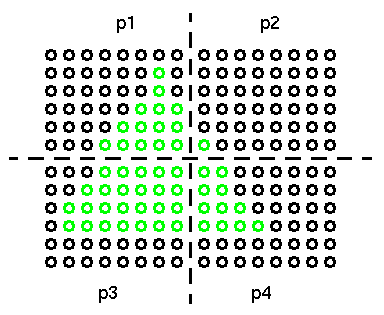Mesh Topology Example
Some problems have a geometric structure in which the values of neighboring points are needed to update a point.
An example is a 2-D image broken into pixels. To "sharpen" the image, a program could check to see if a point (pixel) has an "aberrant" value by comparing it to its neighbors' values. If judged to be aberrant, a new value could be calculated based on the neighboring values.
The best way to parallelize this problem is to block decompose the data in two dimensions and then map the blocks onto a 2-D mesh of processes. The mesh topology is just an abstraction indicating which processes hold neighboring data.

For the points in the interior of each process's block, all the information needed to update the point is held on that process. To update a process's exterior points, rows and columns of points held by neighboring processes are needed.
CVW material development is supported by NSF OAC awards 1854828, 2321040, 2323116 (UT Austin) and 2005506 (Indiana University)